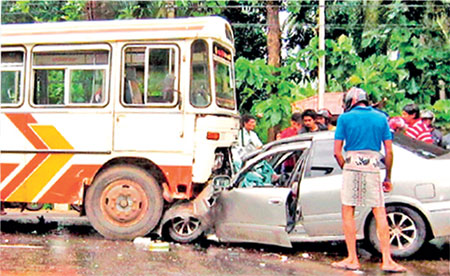Opinion
Road accident killer:

One every three hours
There is a spike of serious traffic accidents and the number of fatalities reported from all parts of the country during the last few weeks. They have snatched many precious and valuable human lives. Media reports, quoting Traffic Police sources indicate, despite the country being in lockdown for three months due to COVID–19, that this year from January to the end of August, 1,418 persons have been killed in traffic accidents
A person is killed every three hours on our roads due to road accidents, and annually 3000 persons die in road accidents. Nearly 8000 serious accidents take place annually, and in many instances the victims end up never to lead a normal life again. In the last four years – in 2016 there were 3017 fatal accidents, while in 2017 it was 3147. In 2018 according to World Health Organization (WHO) data, Road Traffic Accident Deaths in Sri Lanka was 3590, and has been identified as the 10thcause of death in Sri Lanka’s top 50 causes of death, beating other serious diseases causing death in the country. In 2019 there were 2851 fatal accidents.
On September 2nd, a serious accident occurred in the Colombo city at Mattakkuliya. As reported in the media, in that accident three people died instantly when two three-wheelers were hit by a speeding lorry. Apparently, speeding, and driving the lorry without a valid license to drive, is sheer negligence and lack of responsibility of the lorry driver. Lack of care and responsibility for the life of others who share the road is a serious problem. Instilling road discipline in our drivers is paramount for the safety of all road users.
Drivers of motor vehicles need to be responsible and realise, the moment he/she sits at the driver’s seat and holds the steering wheel you are in control of a piece of heavy equipment, at high speed is mere seconds from a potential innocent victim. Furthermore, speed, while greatly increasing the risk of serious crash, increases the odds of an accident and increases its severity.
A driver under the influence of alcohol is as deadly, and similarly at risk of serious accidents. The harmful influence alcohol has on the crucial decision to drive is great. Drinker’s self assessment about whether he/she can drive safely is critical. The deadly influence alcohol has on the driver is great. Alcohol impairs the drinker’s ability of self-assessment. Reduces the driver’s ability to react to things that happen suddenly. The alcohol also blurs vision, impairs attention and reflexes are slowed.
The road accidents having reached such a horrendous proportion, random measures to instil road discipline in errant drivers are not effective. Speeding, reckless driving, and driving under the influence of alcohol are the major causes of serious traffic accidents. The Police launching limited enforcement and special operations during festive seasons, and operations targeting certain Police areas or specific Traffic Rule violations, are not enough to address this tragedy. Police must implement comprehensive long term programmes, employing technology and modern devices to detect traffic rule violations and make roads safe for all road users.
According to Colombo Traffic Police, there are 106 CCTV cameras operating in Colombo and use 3 Mobile CCTV Surveillance Vans to monitor traffic. Surveillance of Colombo using the Road Safety Camera system alone is not sufficient. Road Safety Cameras; Red Light violation detecting cameras, and combined Red Light and Speed cameras can detect a host of Traffic Rule violations. Sri Lanka Police should seriously consider expanding this method of surveillance using the Road Safety Camera system countrywide.
Road Safety Cameras installed at intersections in all cities and major towns, at strategic locations and high risk roads along the country’s entire road network, would be a deterrent to speed maniacs, and other road rule violators who know they are being watched all day and night. These cameras can be used as both detective and preventive measures. It’s a 24/7 surveillance.
The camera captures a host of data including the vehicle number plate, date, time and location of the offence etc., sufficient to prove the offence committed by the driver. In addition, mobile cameras mounted on Police vehicles positioned at strategic locations, and hand held cameras, could be used to book speeding drivers and other road rule violations.
As for alcohol-impaired driving, the government can do more to reduce the number of drunk-driving instances. Couple of years ago the National Authority on Tobacco and Alcohol (NATA) proposed to reduce the maximum Blood Alcohol Concentration (BAC) level of drivers; at present it is 0.08 grams per 100 mm, to 0.03 grams per 100 mm. There is no indication thus far of any initiative of the government taken in this regard. Australia and most European countries have the BAC level of drivers at 0.05. Norway and Sweden in Europe, and China has this level at 0.02, while in Russia it is 0.03. Canada, USA and some countries have it at 0.08.
The government could look into lowering the legal BAC level to 0.03 as proposed by the NATA. This approach would better respond to discouraging drunk-drivers. The government could also consider making instances of driving while exceeding the legally permitted BAC limit, a criminal offence; initially applying it to drivers exceeding the legally permitted BAC level and meeting with accidents, and finally extending to exceeding the permitted BAC level under any circumstances, a criminal offence.
Clearly, the law can’t work on its own. The key factor in the reduction of Traffic Rule violations is enforcement and stiff penalties. Police should be provided with technology and modern devices used in other Police Forces around the world. Police should be given authority to stop and demand to undergo testing from any driver at the roadside more often, rather than testing after accidents occurred.
RAJA WICKRAMASINGHE